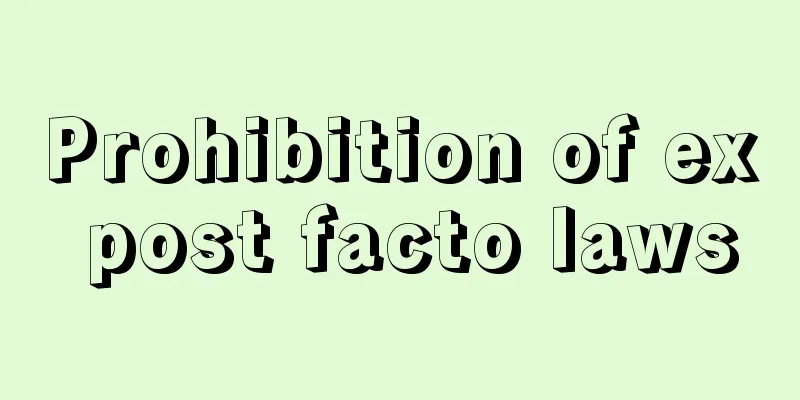Prohibition of ex post facto laws

|
This principle states that a newly enacted law (ex post facto law) should not be applied retroactively to laws that were enacted before the law was enacted. This principle is also called the principle of non-retroactivity of laws. However, the purpose of this principle is applicable when an ex post facto law causes disadvantage or inequality to the parties involved, and it should not be understood in a formal sense. This principle is particularly important in the field of criminal law as a derivative principle of the principle of criminal legality. In response to this, Article 39 of the Constitution stipulates that "No person shall be held criminally responsible for any act that was lawful at the time it was committed." However, in the past, the application of this principle was limited to (1) substantive criminal laws and did not extend to the fields of criminal procedure law and criminal administration law (criminal treatment law), and (2) did not apply to cases where a court changes a precedent to the defendant's disadvantage. In response to this, it has been argued that the intent of the prohibition of ex post facto laws should also be taken into consideration when making changes to laws or precedents that are detrimental to the defendant in terms of whether a crime has been committed or the determination of the sentence (in particular, (2) has been established in American precedents). [Tetsuro Nawa] Source: Shogakukan Encyclopedia Nipponica About Encyclopedia Nipponica Information | Legend |
|
新たに制定された法律(事後法)は、その制定以前にさかのぼって適用してはならない、という原則。法律不遡及(そきゅう)の原則ともいう。ただ、この原則の趣旨は、事後法により関係者に不利益や不平等を生じる場合に妥当し、これを形式的に理解してはならない。この原則は、とくに刑事法の領域において罪刑法定主義の派生的原理として重要な意義をもつ。これを受けて、憲法第39条は、「何人(なんぴと)も、実行の時に適法であつた行為……については、刑事上の責任を問はれない」と規定している。ただ、この原則の適用にあたって、従来、(1)実体的な刑罰法規に限られ刑事手続法や行刑法(犯罪者処遇法)の領域には及ばない、(2)判例の不利益変更、すなわち、裁判所が判例を被告人の不利益に変更する場合には及ばない、とされてきた。 これに対して、実質的に、犯罪の成否や刑の量定にとって被告人に不利益をもたらす法令や判例の変更についても、事後法の禁止の趣旨を考慮すべきである、という考え方が主張されている(とくに、(2)については、アメリカの判例で確立している)。 [名和鐵郎] 出典 小学館 日本大百科全書(ニッポニカ)日本大百科全書(ニッポニカ)について 情報 | 凡例 |
Recommend
Nuevo Laredo (English spelling)
A border city in northeastern Mexico, Tamaulipas s...
Piranga olivacea (English spelling)
…[Nakamura Toru]. … *Some of the terminology that...
Vischer, P. (Father) (English spelling) VischerP
...In the second half of the 14th century, the Pa...
Printed wiring
This is a method of forming electronic circuits b...
Ismail Bey - Ismail Bey
…Official name = Republic of MacedoniaRepublika M...
Serpens (Snake)
Its abbreviation is Ser. A constellation visible i...
Rogers, Ginger
Born July 16, 1911 in Independence, Missouri [Died...
《Archeion》 - Arkeion
…In his later years, he lost his job, was often i...
Rash
Common name for contact dermatitis. Source : Heibo...
Tomomi Narita
Politician. Born in Kagawa Prefecture. After grad...
Princess Wen-cheng (English: Princess Wen-cheng gong-zhu; Princess Wen-ch`êng kung-chu)
[raw]? [Death] 680 A princess of the Tang Dynasty ...
concilia
…The Spartan assembly voted with shouts of approv...
Kamasi language - Kamashigo
...The Serikup language is spoken in the area fro...
Alfred Hettner
German geographer. As a professor at the Universi...
"The grass is bleached in the field" - Imashimegusa susuki no no arashi
...It is similar in concept to the Tenpo Rokkasen...









